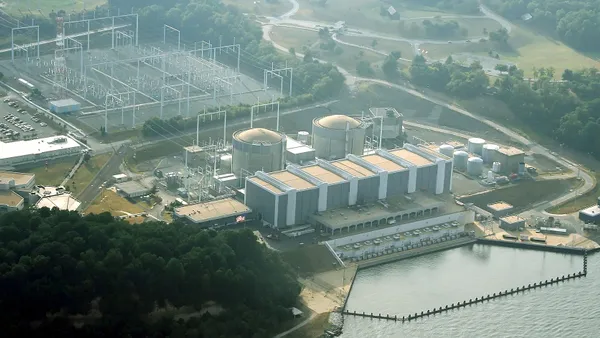The grim reaper is stalking utilities across America. Instead of a scythe, he's carrying a solar panel in his hands.
As homeowners and businesses increasingly cover their roofs with solar panels, the centralized power grid could soon become a "last resort," says David Crane, CEO of NRG Energy, the nation's largest independent power producer and retail electricity provider. And some observers are even suggesting that investor-owned utilities face a possible government bailout due to distributed generation's rapid ascension.
But not so fast. Only 18% of utility executives view distributed generation as a "threat," according to a recent PwC survey. In fact 82% see it as an "opportunity."
So what gives?
Distributed solar appeals to customers
Ted Craver, Edison International's chairman, president and CEO, believes distributed generation offers major opportunities for utility companies.
Craver knows a thing or two about distributed generation. Edison owns Southern California Edison, which serves an area that is at the forefront of rooftop development.
Craver sees the appeal of rooftop solar. “Distributed energy has the potential to offer customers cleaner power, more choices, and more control over their energy bills,” Craver wrote this fall in an essay entitled Raising Our Game. Distributed generation accounts for about 1% of the installed capacity in the U.S., but is poised for major growth, according to Craver.
Distributed resources present challenges to utilities – some in the cost recovery arena – but “on balance, I see them as an opportunity to make our nation’s power grid more flexible and ultimately to better serve our customers,” Craver said.
Distributed generation can provide several benefits to utilities, including increasing customer engagement and delaying the need for new power lines and power plants, according to Craver.
So why aren't more utilities investing in DG?
Edison invests in distributed generation
As it turns out, some utilities are investing in distributed generation.
Edison International sees its role in the distributed generation sector as providing capital and engineering know-how, Craver said during a late October earnings conference call with analysts.
But Craver isn't just talking a good game. Edison has been investing in distributed generation-related companies. In August, Edison bought Chicago-based SoCore Energy, a distributed developer focused on the commercial and industrial market. Earlier this year, Edison, along with Duke Energy and two other unnamed utilities, invested in Clean Power Finance, which provides over a half billion dollars worth of financial services and software to the distributed solar industry.
The grid is poised for major change, according to Edison. The company sees “the need for infrastructure investment to transform the distribution grid from a radial system accommodating one-way flows of electricity to a more advanced and flexible system capable of two-way electrical flows,” Craver said. “Such a system is needed to better enable distributed energy resources such as rooftop solar, electric transportation and energy storage.”
Part of the rise in distributed generation is being driven by the drop in solar costs. In 2002, rooftop solar larger than 100 kW cost about $9/W. The costs have dropped to around $4.75/W, with a sharp decline starting around 2009, according to Edison. The levelized cost of distributed generation continues to move toward equilibrium with traditional generation resources, Edison said.
In a move related to distributed solar, Southern California Edison will also be investing in energy storage. The California Public Utilities Commission in October set a 1,325-MW target by 2020 for energy storage. Under the policy, Southern California Edison is required to procure 580 MW of storage resources. The utility can own up to half the capacity.
Utilities acting on distributed generation
Edison is not alone in jumping head first into distributed generation.
For one, the Long Island Power Authority expects it rooftop solar program will save ratepayers money. Integrys Energy Services, which has a partnership with Duke Energy, owns about 100 MW of small-scale solar around the U.S. And earlier this year, NextEra Energy Resources, parent to Florida Power & Light, bought Smart Energy Capital, which provides solar services to large customers.
There are three potential business models for utility involvement in distributed solar, according to Kristian Hanelt, senior vice president for renewable capital markets at Clean Power Finance.
Utilities can invest in solar outside their regulated service territory; they can earn a rate of return on rooftop investments in their territory; and, they can offer solar as part of selling other technologies like electric vehicle charging stations, Hanelt said during a Solar Electric Power Association presentation.
But not all utilities are interested in investing.
Pinnacle West Capital, parent to Arizona Public Service, which serves prime rooftop territory, sees no direct role for the company in distributed generation. “Our plans in the solar space would be more utility scale with [power purchase agreements] to creditworthy customers,” said James Hatfield, Pinnacle West chief financial officer, during an October 31 earnings conference call.
APS, which recently sought to impose a stiff fee on owners of rooftop solar, may be missing the boat on rooftop solar.
Outlook for 2014 and beyond
To invest or not invest in distributed generation, that is the question. And the answer should come in 2014. Expect utilities to make decisions on this key issue soon if they haven't already.
Some utilities will invest, while others will choose to resist the changing tide and fight for higher distributed generation fees and against solar-friendly net metering policies. Where utilities fall on this issue will not only shape their future, but that of the industry at large.
Keep an eye on utility companies like NextEra, Duke and Integrys that believe there's money to made in distributed generation.
We'll leave the last word to Charles Darwin, who Craver quoted in his essay: “It is not the strongest of the species that survives, nor the most intelligent that survives. It is the one that is the most adaptable to change.”
Enjoyed what you read? You may also want to read Utility Dive's look at the 4 greatest challenges that utilities face in 2014.





















